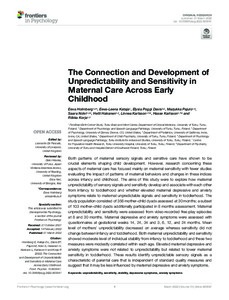Hae
Aineistot 31-40 / 52
Associations between observed and reported infant negative affectivity, fear and self-regulation, and early communicative development-Evidence from the FinnBrain Birth Cohort Study
Self-regulation and language are intertwined abilities, but the nature of their relations in early childhood when both skills are still emerging is insufficiently understood. Our knowledge of the relations between early ...
Newborn left amygdala volume associates with attention disengagement from fearful faces at eight months
<p>After 5 months of age, infants begin to prioritize attention to fearful over other facial expressions. One key proposition is that amygdala and related early-maturing subcortical network, is important for emergence of this attentional bias – however, empirical data to support these assertions are lacking. In this prospective longitudinal study, we measured amygdala volumes from MR images in 65 healthy neonates at 2–5 weeks of gestation corrected age and attention disengagement from fearful vs. non-fearful facial expressions at 8 months with eye tracking. Overall, infants were less likely to disengage from fearful than happy/neutral faces, demonstrating an age-typical bias for fear. Left, but not right, amygdala volume (corrected for intracranial volume) was positively associated with the likelihood of disengaging attention from fearful faces to a salient lateral distractor (r = .302, p = .014). No association was observed with the disengagement from neutral or happy faces in equivalent conditions (r = .166 and .125, p = .186 and .320, respectively). These results are the first to link the amygdala volume with the emerging perceptual vigilance for fearful faces during infancy. They suggest a link from the prenatally defined variability in the amygdala size to early postnatal emotional and social traits.<br /></p>...
The Connection and Development of Unpredictability and Sensitivity in Maternal Care Across Early Childhood
<p>Both patterns of maternal sensory signals and sensitive care have shown to be crucial elements shaping child development. However, research concerning these aspects of maternal care has focused mainly on maternal ...
Sex-specific associations between maternal pregnancy-specific anxiety and newborn amygdalar volumes-preliminary findings from the FinnBrain Birth Cohort Study
Previous literature links maternal pregnancy-specific anxiety (PSA) with later difficulties in child emotional and social cognition as well as memory, functions closely related to the amygdala and the hippocampus. Some ...
Individual differences in pupil dilation to others' emotional and neutral eyes with varying pupil sizes
Sensitivity to others' emotional signals is an important factor for social interaction. While many studies of emotional reactivity focus on facial emotional expressions, signals such as pupil dilation which can indicate ...
Vanhempien masennus- ja ahdistusoireet lisääntyivät COVID-19-pandemian alkuvaiheessa - FinnBrain-syntymäkohorttitutkimus
<p>JOHDANTO : Aikuisten psyykkisen oireilun on havaittu lisääntyneen COVID-19-pandemian aikana. Harvassa tutkimuksessa on selvitetty pienten ja kouluikäisten lasten vanhempien oireiden muutosta toistomittausasetelmassa.< ...
Associations between temperament dimensions and dental anxiety in parents of the FinnBrain Birth Cohort Study
We evaluated associations between dental anxiety and four temperament dimensions: effortful control, extraversion/surgency, negative affect and orienting sensitivity among 2558 parents in the FinnBrain Birth Cohort Study. ...
Maternal Psychological Distress and Executive Functions Are Associated During Early Parenthood - A FinnBrain Birth Cohort Study
<p><br></p><p>Parental executive functioning (EF) and parenting behaviors can be affected by the multiple stressors that are often present during early parenthood. However, little is known about how commonly experienced ...








